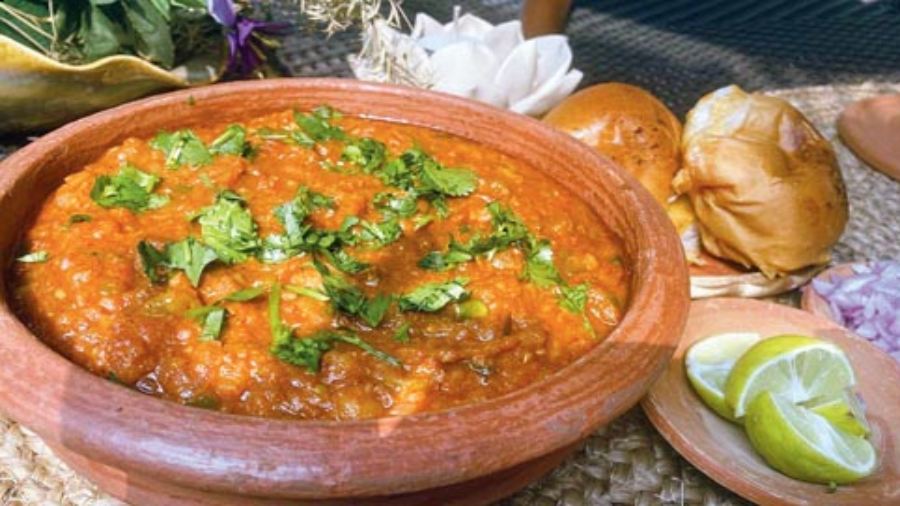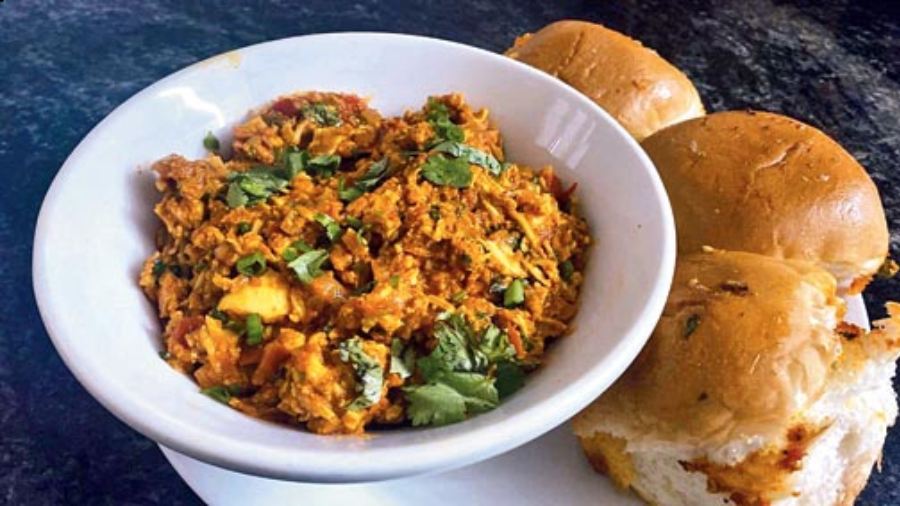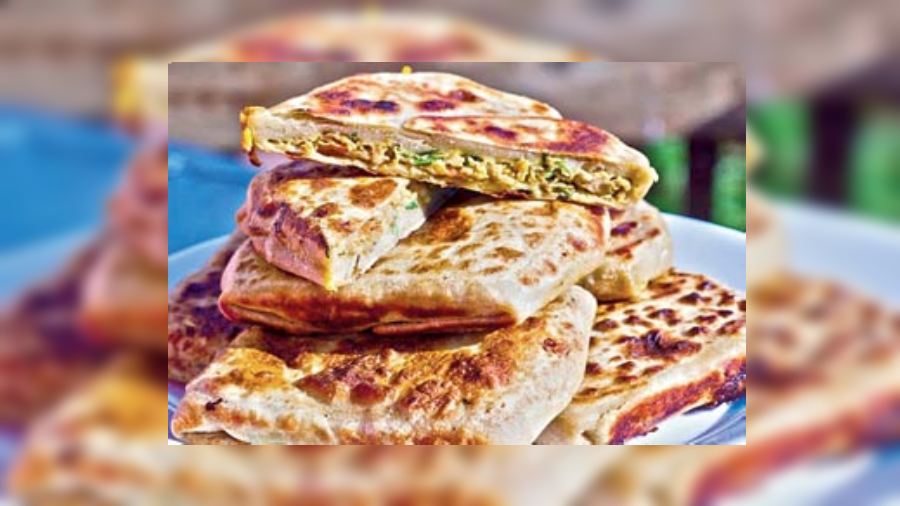Mumbai being the capital and largest urban area of Maharashtra, is dominated by various types of street food, considering it has a very large and cosmopolitan population. Therefore, the variety of street food is enormous. The vegetarian and non-vegetarian street food is also defined by certain areas. For instance, Mohammed Ali Road and Bhendi Bazar are famous for Baida (egg) Keema Roti, Anda Ghotala and Keema Pav Kebabs, among others. Places like Shivaji Park and Dadar are well-known for their Vada Pav, Pav Bhaji, Toastie, Missal Pav, etc. Mumbai street food has now made its way into kitchens of restaurants, including five-star hotels. In fact, some of the dishes have become popular around the world.
CHICKEN FRANKIE
In 1967, a pharmacist and famous hockey player, Amar Singh Tibb created Chicken Frankie after having had a shawarma in Beirut. He swapped the lamb for chicken and Indian spices. The first outlet was founded in Colaba Causeway. Chicken Frankie, which is basically a roll, can now be found all over Mumbai and Maharashtra.
INGREDIENTS
#For the Frankie roti
• Flour: 2 cups
• Salt: 1tsp
• Oil: 2-3tbsp
• Water: As required for kneading the dough
#For the chicken
• Chicken breasts: 2 boneless, sliced thinly lengthwise
• Onions: 2, chopped very fine
• Ginger-garlic paste: 2tsp
• Green chillies: 2, chopped very fine (or you can make a paste)
• Tomatoes: 2, chopped very fine
• Cumin seeds: 1tsp
• Turmeric powder: ½tsp
• Red Kashmiri chilli powder: 2tsp
• Chicken masala: 2tsp
• Yoghurt: ½ cup
• Cashew paste: 2tsp
• Capsicum: ½, chopped very finely into small pieces (this gives a good flavour to the chicken)
• Tomato ketchup: 2tbsp
• Coriander leaves: 2-3tbsp
#For garnishing
• Onions sliced and kept in vinegar and a little salt
• Eggs: Beaten
METHOD
#For the Frankie roti
• Knead a smooth and soft dough. Let it rest for about an hour after brushing it with little oil.
• Then make roundels. Roll into thin chappatis and half-cook them and keep aside for later use. The rotis should not be stiff, but soft. Do not use oil when roasting the rotis at this point.
#For the chicken
• Heat oil in a non-stick pan. Add cumin seeds. Let it crackle and then add the onions and sauté well till pale golden brown. Then add ginger, garlic and green chillies. Saute for a minute till the raw smell goes.
• Now add the tomatoes, capsicum red chilli powder, chicken masala, turmeric. Saute for 2 minutes until the tomatoes are nice and mushy. Add the tomato ketchup. Now add the chicken and sauté with the masala till everything is well combined. This will take about 4 minutes.
• Now add the beaten curd and cashew paste and cook for another 2-3 minutes. The mixture should not be lumpy. Everything should be well-combined and the chicken cooked properly. Now add the coriander leaves and switch off the gas.
#For assembling
• Heat a non-stick tawa and cook the half-cooked roti on both sides for 1 minute.
• Remove the roti and put 1tsp oil. Pour one beaten egg on the tawa. Now put the roti on top of the egg and let it cook for a few seconds. Flip the roti. Pour 1tsp oil under the roti. Cook till it is nicely done.
• Remove the roti and place on parchment paper egg side up. Put a generous helping of the chicken mixture. Garnish with drained out sliced vinegar onions. (Optional salad leaves.) Now tightly roll with the parchment paper and twist the ends. The Chicken Frankie is ready to be served.
BOMBAY TOASTIE

One of Mumbai’s most popular street snacks, the sandwich is a simple combination of carbs and fibre. It is ostensibly fresh and healthy and has an explosion of textures and masalas. A colonial inheritance, the sandwich is generally attributed to John Montagu, the fourth Earl of Sandwich, who is said to have eaten his meals in this form to avoid getting up from the gaming table in the 16th century. The Bombay toastie was developed to fuel the immigrant workers during the 1960s.
INGREDIENTS
#For the chutney
• Coriander leaves: 2 cups
• Grated coconut: 1 cup
• Green chillies: 5
• Garlic: 8 cloves
• Lemon juice: 1tbsp
• Sugar: 1tsp (or according to taste)
• Salt: To taste
#For the Toastie masala
• Cumin powder: ½tsp
• Ginger powder (sonth): ½tsp
• Fennel powder: ½tsp
• Pomegranate seeds: ¼tsp, ground
• Black salt: ¼tsp
• Salt: A pinch
• Asafoetida (hing): A pinch
#For the filling
• Bread slices well-buttered on both sides
• Tomatoes: Finely sliced
• Capsicum: Sliced round and thin
• Potatoes: Boiled and sliced round and thin
• Cucumber: Sliced round and thin
METHOD
• For the chutney, blend all its ingredients listed above together into a paste.
• Spread the chutney on the buttered bread slice. Both of them. Then put boiled potato slices. Sprinkle a little masala powder on it. Then place tomato slices. Over it place cucumber slices. Over it place capsicum slices. Sprinkle little more of the masala powder.
• Optionally, you can sprinkle a little cheese.
• Now cover with the other slice. Press it down a little.
• Now put it in a greased sandwich toaster. Grill it directly over the flame on both sides.
• It just takes about a minute on each side. You can always open and check if it has become nice and brown.
• Serve cut in triangle style and enjoy with ketchup or chilli sauce.
PAV BHAJI

Pav Bhaji is one of the most popular fast foods, not only in Mumbai but throughout India. Now, the world has also got hooked on to it. It is a medley of vegetables, healthy as well as economical. Truly a vegetarian’s delight.
INGREDIENTS:
• Potatoes: 4, peeled and diced
• Cauliflower florets: Of half a cauliflower
• Beetroot: 1 slice (mainly for colour)
• Green peas: 1 cup
• Carrots: 2 medium size, diced
• Onions: 3, chopped fine
• Capsicum: 1, chopped fine
• Tomatoes: 4 large, grated
• Tomato puree: 1 small carton
• Ginger garlic paste: 1tbsp
• Green chillies: 3, chopped fine
• Cumin powder: 1tsp
• Coriander powder: 1tsp
• Red Kashmiri chilli powder: 2tsp
• Pav Bhaji masala: 3-4tsp
• Salt: To taste
• Coriander leaves: A small bunch
• Pavs and butter: As required
• Lemon slices: Cut into wedges
METHOD:
• In a pressure cooker boil potatoes, carrots, peas, beetroot and cauliflower in 1 cup of water. Pressure cook for 3 -4 whistles.
• Remove the vegetables and retain the liquid in which the vegetables were boiled.
• Now mash the vegetables with a potato masher.
• Heat a kadhai and add 2tbsp of butter and 1tbsp oil.
• Add the onions and saute till golden brown. Halfway through add ginger garlic paste.
• Once the onions are golden add the capsicum. Saute for about 2 minutes.
• Now add the tomatoes. Then add tomato puree and green chillies. Add red chilli powder, cumin and coriander powders and salt. Let it cook for about 2 minutes.
• Now add the pressure cooked vegetables.
• Add the pav bhaji masala and mix well. Mash the vegetables again. Then add the liquid we had retained. Cover and cook for 6-7 minutes. The consistency should be little loose, not lumpy.
• Now add 1-2tbsp of butter on top. Garnish with coriander leaves. The Bhaji is ready. Remove and keep aside.
• Cut the pav in half. In the same pan add a little butter and warm the pavs on both sides. It will soak up the butter and the stuck leftovers of the Bhaji.
• Delicious Pav Bhaji is ready to be served.
ANDA GHOTALA

Anda Ghotala, which translates into egg scam or confusion, is a very popular egg dish. This delicious street food is usually found around Mohammed Ali Road and Bhendi Bazaar. Now, of course, it has spread throughout Mumbai. This recipe is basically eggs cooked in various ways and brought together in one dish. It tastes best with buttered pav. It originated in Surat in Gujarat. So it is also called Surti Anda Ghotala.
INGREDIENTS
• Eggs: 2 full boiled
• Eggs: Plus 4 more
• Onions: 2 medium size, finely chopped
• Tomatoes: 2, finely chopped
• Ginger paste: 1tsp
• Garlic paste: 1tsp
• Green chillies: 4, very finely chopped
• Cumin powder: 1tsp
• Coriander powder: 1tsp
• Turmeric powder: ½tsp
• Garam masala powder: ½tsp
• Red chilli powder (Kashmiri): 2tsp
• Salt: To taste
• Butter: 2tbsp
• Oil: 1tbsp
• Spring onions: 4tbsp, finely chopped
• Coriander leaves: Small bunch, finely chopped
• Pavs: As per requirement
METHOD
• In a skillet heat butter and oil.
• Add onions and saute till light brown.
• Add ginger and garlic pastes. Green chillies. Saute for 1 minute.
• Now add the tomatoes and cook till they are mushy.
• Add red chilli powder, turmeric, cumin, coriander and garam masala powder. Add salt to taste.
• Saute till everything is well-combined and the tomatoes and masalas are cooked well.
• Add ¼ cup water and cook for a few seconds.
• Now add grated boiled eggs and mix everything well.
• Mash with a potato masher. Add 2tbsps of water if necessary. The mixture should not get dry.
• Slide the mixture to one side of the skillet. On the empty side break two eggs adding a little butter. The eggs should be soft.
• Now mix the sunny side up eggs to the rest of the mixture. Mix well. Cook for a few seconds.
• Add the spring onions and coriander leaves.
Note: This Ghotala can also be served with a sunny side egg on top. (That is why I said eggs 3 ways).
• Serve with warm buttered pavs.
KEEMA BAIDA ROTI

Crispy Keema Baida Roti (keema-egg roti) is a shallow-fried roti stuffed with minced meat or chicken and egg. It is one of the common Iftar dishes during the month of Ramadan, though one can enjoy this delicacy throughout the year. In Mumbai, it is a very popular street food in areas like Mazagoan and Crawford Market. It seems to have originated in Burma. The people in Surat who started making this recipe previously lived and worked in Burma and later came to India and settled in the Surat and Rander area. They also brought Burmese Khowsuey with them.
INGREDIENTS
• Mince meat/chicken: 250g
• Onions: 2 medium, finely chopped
• Ginger-garlic paste: 1tbsp
• Green chilli paste: 1tsp
• Tomato: 1, finely chopped
• Cumin powder: 1tsp
• Coriander powder: 1tsp
• Turmeric powder: ½tsp
• Garam masala powder: ½tsp
• Red chilli powder: 1tsp
• Coriander leaves: 1tbsp chopped
#For the roti
• All-purpose flour: 2 cups
• Salt: ½tsp
• Oil: 2tbsp
• Water: For kneading a smooth dough (Let it rest for ½ hour.)
METHOD
#For making the keema
• In a pressure cooker heat oil. Then add onions and saute till golden brown. Add ginger garlic paste and green chilli paste. Add the keema and sear well for at least 4-5 minutes till it changes colour.
• Then add tomatoes and all the powdered masalas. Saute for 2-3 minutes till the tomatoes and masalas are well blended.
• Now add 1½ cups water and pressure cook for 3-4 whistles. The keema should be well-cooked and water dried up,
• Remove and add coriander leaves. Keep aside.
#For making the roti
• Make roundels of the dough. On your work surface roll each roundel to 8-10 inches across. You have to roll it very thin. You should be able to see the work surface.
• Now in the middle put a little of the keema. Over it pour one beaten egg. Now Bring the top edge of the roti very carefully to the middle. Then the lower edge of the roti to overlap the top edge. Then the side edge to the middle. It is like making a packet. Then the other side edge to overlap the other side edge. The packet will now be sealed on all sides.
• Heat a tawa and put enough oil for shallow frying. Carefully lift the packet and put in the oil. Let it brown and then carefully flip it over and cook till golden brown and crisp.
• Do the same with other rotis. Then cut them into squares. Enjoy with ketchup or green chutney.
VADA PAV

Vada Pav was originally created for migrant mill workers in mill village (Parel). It was invented by Ashok Vaidya, a street vendor outside Dadar station in the late 1960s. The Mumbaiker would do well to remember that pav (derived from the Portuguese word for bread), potatoes and chillies were all brought to India by outsiders.
INGREDIENTS
#For the potato filling
• Oil: 2tbsp
• Mustard seeds: ½tbsp
• Curry leaves: 1 sprig
• Garlic: 6-7 cloves, minced
• Ginger: ½ inch piece, minced
• Green chillies: 2, chopped very fine
• Turmeric: ¼tsp
• Potatoes: 6, boiled and crushed
• Salt: ¼tsp
• Coriander leaves: 1tbsp
• Lemon juice: 1tsp
#For batter for the vadas
• Besan (gram flour): 3 cups
• Rice flour: 2tbsp
• Salt: 1tsp
• Red chilli powder: ½tsp
• Water: For making a thick batter which will coat the roundels of potatoes. It should not be lumpy.
• Oil: For deep frying
#For the dry garlic chutney (which gives so much taste to the Vada Pav)
• Oil: ½tsp
• Garlic: 10-12 cloves
• Coconut: 3tbsp, grated
• Peanuts: 3tbsp
• Sesame seeds: ½tsp, roasted
• Cumin seeds: ½tsp
• Coriander seeds: ½tsp
• Red chilli powder: 1tbsp
#For the green chutney
• Lemon juice: Of 1½ lemons
• Coriander leaves: 2 small bunches
• Green chillies: 2-3
• Mint leaves: 10
• Bhujia (any good brand): 2tbsp
• Curd: ½ cup
• Black salt: ½tsp
METHOD
#For the potato filling
• In a kadai heat oil. Add mustard seeds and curry leaves. Let the mustard seeds pop. Then add garlic. Ginger and green chillies. Saute for a few seconds. Then add turmeric and potatoes and mix well and cook for 2 minutes until everything is combined well.
•Then add coriander leaves and a dash of lemon juice. Keep aside.
#For batter for the vadas
• Divide the potato mixture into 8 rounds (you can make it as big as you want).
• Dip the vadas in batter and deep-fry in medium hot oil until golden and then remove on kitchen tissue.
#For the dry garlic chutney (which gives so much taste to the Vada Pav)
• In a pan add oil and garlic. Cook the garlic until golden spots appear. Remove from the pan.
• In the same pan add the peanuts and roast till half done. Add the coconut and sesame, cumin, coriander and roast on low flame until golden. Transfer to a bowl and add red chilli powder and salt. Let it cool and then grind to a coarse powder.
#For the green chutney
• Blend all the ingredients into a smooth paste.
#For assembling the Vada Pavs
• Cut the pav in half. Don’t cut it through. Heat the pav. Spread the green chutney on one side. Place the fried vada over it. Spread the red garlic dry powder on the other half and then press the pav closed but not too much.
• The delicious Vada Pav is ready to eat.
Durri Bhalla is a cookery expert and author of Indian Bohra Cuisine and Inner Truth To Good Health And Weight Loss. You can find her at @DurriBhallaKitchen on Instagram, Durri’s Kitchen on Facebook and Durri Bhalla on YouTube
